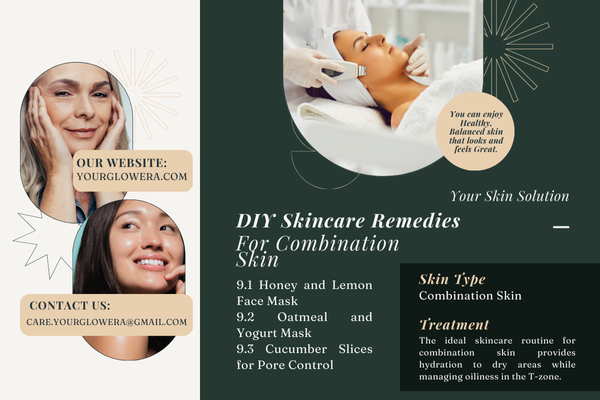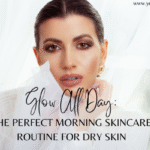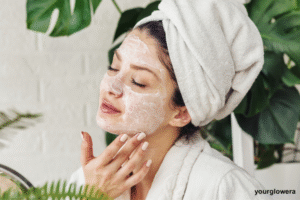If you have combination skin, you’re probably familiar with the unique challenge of caring for an oily T-zone while also managing dry cheeks.
The best skincare routine for combination skin provides hydration to dry areas while managing oiliness in the T-zone. It may sound tricky, but with the right products and a consistent routine, it’s easier than you think!
In this article, we’ll break down the essentials of a skincare routine for combination skin, help you choose the best budget-friendly products, and give you practical tips to keep your skin balanced and healthy.
Whether you’re just starting your skincare journey or are looking to refine your existing routine, this guide will make it all clearer.
Table of Contents
Understanding Combination Skin
Before diving into the best skincare routine for combination skin, it’s important to understand what this skin type actually is.
Combination skin refers to a complexion that exhibits characteristics of both dry and oily skin, often simultaneously. For many, this means an oily T-zone (forehead, nose, and chin) and drier, sometimes sensitive cheeks.
This skin type needs a balanced approach: hydrating dry areas without increasing oiliness in the T-zone. Let’s explore the key components of a successful skincare regimen for combination skin, ensuring you achieve the best skincare routine for combination skin.
Step 1: Cleanse Properly
1.1 Why Cleansing is Essential for Combination Skin
Cleansing serves as the foundation of any skincare routine, and it’s particularly crucial for combination skin. A good cleanser helps remove dirt, oil, and makeup, giving your skin a fresh canvas to absorb the next steps of your routine.
1.2 Choose the Right Cleanser
Opt for a gentle, foaming cleanser that’s free of harsh sulfates. Look for ingredients like glycerin or hyaluronic acid that hydrate the skin without leaving it greasy.
1.3 Cleansing Tips for Combination Skin
Don’t over-cleanse. Washing your face twice daily is enough. Over-cleansing can strip your skin of natural oils, exacerbating dryness in some areas.
Step 2: Exfoliate Gently
2.1 The Importance of Exfoliating
Exfoliating helps eliminate dead skin cells, which can cause your skin to look dull. For combination skin, a gentle exfoliation is key, especially in the oily areas where pores can get clogged, making it an important step in the best skincare routine for combination skin.
2.2 Choosing an Exfoliant
Go for a chemical exfoliant (like AHAs or BHAs) rather than a harsh physical scrub. These are gentler and can be more effective at unclogging pores in the T-zone.
2.3 Exfoliation Frequency
Exfoliate once or twice a week to prevent buildup, but avoid overdoing it as it can irritate dry areas.
Step 3: Tone for Balance
3.1 Why Toning Matters
Toners help balance the skin’s pH, tighten pores, and provide hydration, making them a beneficial step in your skincare routine. For combination skin, a toner can help manage oil in the T-zone while soothing the dry patches, making it an essential part of the best skincare routine for combination skin.
3.2 Best Toners for Combination Skin
Look for alcohol-free toners that contain soothing ingredients like aloe or chamomile. Witch hazel is also a great option for tightening pores in the oily areas.
3.3 How to Apply Toner
Gently apply your toner with a cotton pad, focusing on the T-zone. Instead of rubbing, gently pat to help prevent irritation.
Step 4: Moisturize with Care
4.1 Moisturizing Isn’t Optional
Even if your T-zone is oily, moisturizing is still a must. Skipping this step can lead to more oil production, as your skin compensates for dryness.
4.2 Choose a Lightweight Moisturizer
A gel-based or oil-free moisturizer is ideal for those with combination skin. These formulas provide hydration without making the skin feel greasy.
4.3 Apply Moisturizer Evenly
Be sure to apply the moisturizer evenly across your face. If you need extra moisture on the dry patches, apply a little more product in those areas.

Step 5: Protect with Sunscreen
5.1 Why SPF is Crucial
It’s important to safeguard your skin from the sun’s harmful rays, even if you have combination skin. Sunscreen prevents premature aging, dark spots, and other skin issues.
5.2 Best Sunscreens for Combination Skin
Choose a broad-spectrum SPF of at least 30 or higher to ensure adequate protection. A lightweight, non-comedogenic sunscreen that won’t clog pores is essential for the best skincare routine for combination skin.
5.3 Daily Sunscreen Application
Incorporate sunscreen into your daily routine, even when you’re mostly indoors. Apply the sunscreen generously to all exposed skin and reapply as needed to maintain protection throughout the day.
Step 6: Target Specific Skin Concerns
6.1 Treating Breakouts
If you struggle with acne in your T-zone, spot treatments with ingredients like benzoyl peroxide or salicylic acid can be effective. Apply only to the affected areas to prevent drying out the rest of your face, making it a helpful step in the best skincare routine for combination skin.
6.2 Hydrating Dry Areas
For dry areas, use a rich, nourishing serum or oil that targets hydration. Choose products that contain ingredients such as vitamin E, hyaluronic acid, and ceramides.
6.3 Sensitive Skin Solutions
If your combination skin also includes sensitive spots, use products with calming ingredients like oat extract or calendula to soothe irritation.
Step 7: Adjust Based on the Season
7.1 Winter Skincare for Combination Skin
In colder months, combination skin tends to get drier, especially in the cheeks. Switch to a richer moisturizer and incorporate a hydrating serum to lock in moisture.
7.2 Summer Skincare for Combination Skin
In the summer, you might find that your T-zone becomes oilier. Use a mattifying primer and lightweight gel moisturizers to keep oil under control.
Step 8: Best Budget-Friendly Products for Combination Skin
8.1 Cleansers Under Budget
Look for affordable options like Cetaphil Daily Facial Cleanser or CeraVe Hydrating Cleanser that offer great results without breaking the bank.
8.2 Affordable Moisturizers
Neutrogena Hydro Boost Water Gel is a lightweight moisturizer that hydrates while keeping your T-zone in check, all for a reasonable price.
8.3 Sunscreens That Won’t Break the Bank
EltaMD UV Clear SPF 46 is a fantastic sunscreen for combination skin, offering broad-spectrum protection without clogging pores.
Step 9: DIY Skincare Remedies for Combination Skin
9.1 Honey and Lemon Face Mask
Honey has moisturizing properties, while lemon acts as a natural astringent. A mask of both can help balance your skin’s hydration levels.
9.2 Oatmeal and Yogurt Mask
Mixing oatmeal and yogurt creates a soothing mask that calms dry skin while removing excess oils from the T-zone.
9.3 Cucumber Slices for Pore Control
Placing cucumber slices directly on the T-zone can help decrease oiliness and calm inflammation.

Step 10: Lifestyle Tips for Healthy Skin
10.1 Eat for Skin Health
Consuming foods high in antioxidants, omega-3 fatty acids, and vitamins can promote healthy skin nourishment from within. Incorporate more leafy greens, fatty fish, and nuts into your diet.
10.2 Stay Hydrated
Drinking plenty of water helps maintain your skin’s moisture balance, ensuring that both the oily and dry areas stay hydrated.
10.3 Get Enough Sleep
Getting quality sleep is crucial for effective skin repair and the regeneration process. Aim for 7-9 hours of sleep every night to give your skin the rest it needs.
Step 11: Avoid These Skincare Mistakes
11.1 Overloading on Products
Using too many skincare products can overwhelm your skin, potentially causing irritation, breakouts, or dryness. Keep your routine simple with essential products.
11.2 Skipping Sunscreen
Never skip sunscreen, even if it’s cloudy or you’re inside. UV rays can still harm your skin and contribute to premature aging.
11.3 Using Harsh Products
Stay away from products containing high levels of alcohol, as they can lead to skin dryness. Always choose gentle formulations.

Conclusion: Achieving a Balanced Skincare Routine
Tailor Your Routine to Your Skin
The best skincare routine for combination skin is all about balance and personalization. Since each person’s skin is different, it’s important to create a customized routine tailored to your particular skin concerns.
Pay close attention to how your skin responds to different products and adjust accordingly. By understanding which areas of your face need hydration and which need oil control, you can achieve a skincare routine that helps your skin feel healthy and balanced every day.
Consistency is Key
Consistency is the most crucial factor when it comes to skincare, particularly for combination skin. Ignoring certain skincare steps or constantly changing products can disrupt your skin’s balance, making it essential to follow the best skincare routine for combination skin.
Therefore, it’s important to stick to a consistent routine and be patient with your skincare journey. After all, consistency is what will eventually help you achieve that smooth, glowing complexion you desire.
Be Patient and Enjoy the Process
Achieving healthy, glowing skin takes time, and it’s important to have realistic expectations. You won’t see results overnight, but by sticking to a routine, you’ll start noticing improvements over time.
It’s also essential to enjoy the process—skin care doesn’t have to be a chore! Take the time to pamper yourself, try new products, and learn more about your skin. The better you understand your skin’s needs, the easier it will be to care for it with the best skincare routine for combination skin.
If you’re looking for the perfect skincare routine that caters to your unique skin type, check out our blog post on the “Best Skincare Routine for Combination Skin: Achieve a Balanced, Glowing Complexion Every Day“.
In this post, we provide expert tips and easy-to-follow steps to help you maintain a healthy, glowing complexion while keeping your combination skin perfectly balanced. Don’t miss out on these valuable insights!
Frequently Asked Questions
1. Is niacinamide good for combination skin?
Yes, niacinamide is fantastic for combination skin as it helps reduce oil production in the T-zone and hydrates dry areas, making it a key ingredient in the best skincare routine for combination skin. It also helps minimize pores and reduce redness, promoting a more even complexion.
2. Which is the best brand for combination skin?
CeraVe, Neutrogena, La Roche-Posay, and Clinique are some of the best brands offering products specifically for combination skin, making them essential for the best skincare routine for combination skin.
3. What is bad for combination skin?
Avoid products with high alcohol content, heavy oils, or harsh ingredients that may irritate sensitive or dry areas or clog pores in oily areas, ensuring the best skincare routine for combination skin. Look for gentle, non-comedogenic formulations to maintain a balanced complexion.
4. What’s the best face moisturizer for combination skin?
Look for a lightweight, non-comedogenic moisturizer, such as Neutrogena Hydro Boost Water Gel or CeraVe Daily Moisturizing Lotion, perfect for the best skincare routine for combination skin to hydrate without clogging pores.
5. Which serum is best for the face?
For combination skin, serums containing vitamin C, niacinamide, or hyaluronic acid are the best. The Ordinary Niacinamide 10% + Zinc 1% and La Roche-Posay Pure Vitamin C Face Serum are top picks.
6. Why is my skin getting darker after using vitamin C serum?
Vitamin C may cause hyperpigmentation in some cases if used improperly, particularly if you don’t use sunscreen afterward. Ensure you apply sunscreen during the day as part of the best skincare routine for combination skin to protect your skin from further damage.
7. What is the best skincare routine for combination skin?
A basic skincare routine for combination skin includes: gentle cleanser, exfoliant (2-3 times a week), hydrating toner, serum, moisturizer, and sunscreen, forming the foundation of the best skincare routine for combination skin.
8. Is Cetaphil good for combination skin?
Yes, Cetaphil Daily Facial Cleanser is gentle, non-stripping, and perfect for combination skin, making it an ideal choice for the best skincare routine for combination skin. It effectively cleanses without disrupting the skin’s natural balance.
9. Which sunscreen is suitable for combination skin?
Choose an oil-free, lightweight sunscreen like EltaMD UV Clear Broad-Spectrum SPF 46 or Neutrogena Clear Face Sunscreen SPF 55, perfect for the best skincare routine for combination skin.
10. Which Facewash is best for combination skin?
CeraVe Foaming Facial Cleanser and Neutrogena Hydro Boost Hydrating Cleansing Gel are great options for combination skin.
11. What does niacinamide do for skin?
Niacinamide helps to reduce inflammation, balance oil production, and minimize pore size. It also helps brighten the skin and is excellent for combination skin, addressing both the oily T-zone and dry patches, making it a key ingredient in the best skincare routine for combination skin.
12. When to apply toner in the best skincare routine for combination skin?
Toner should be applied after cleansing and before applying any serums or moisturizers. It helps prepare the skin to absorb subsequent products more effectively.
13. Which Korean skincare is best for combination skin?
Some great Korean skincare products for combination skin include Laneige Water Sleeping Mask (hydrating), Innisfree Green Tea Seed Serum (balancing and soothing), and Etude House SoonJung Toner (gentle and hydrating), making them ideal for the best skincare routine for combination skin.
14. Which face serum is best for combination skin?
Serums with niacinamide, hyaluronic acid, and vitamin C are ideal for combination skin. Consider The Ordinary Niacinamide 10% + Zinc 1%, L’Oréal Revitalift Bright Reveal Serum, or La Roche-Posay Pure Vitamin C Face Serum.
15. Is rice water good for combination skin?
Yes, rice water is beneficial for combination skin. It helps to hydrate and brighten the skin while balancing oil production, making it an excellent natural remedy for the best skincare routine for combination skin.









Leave a reply